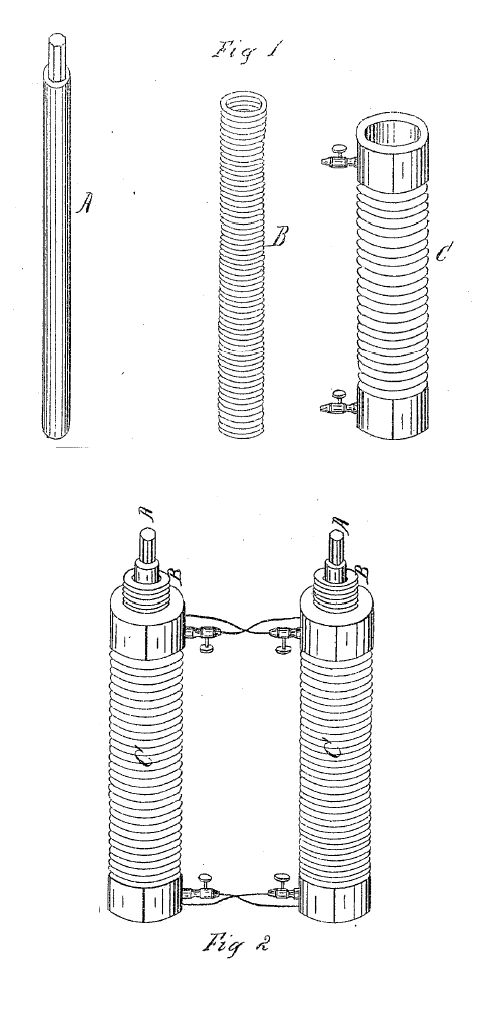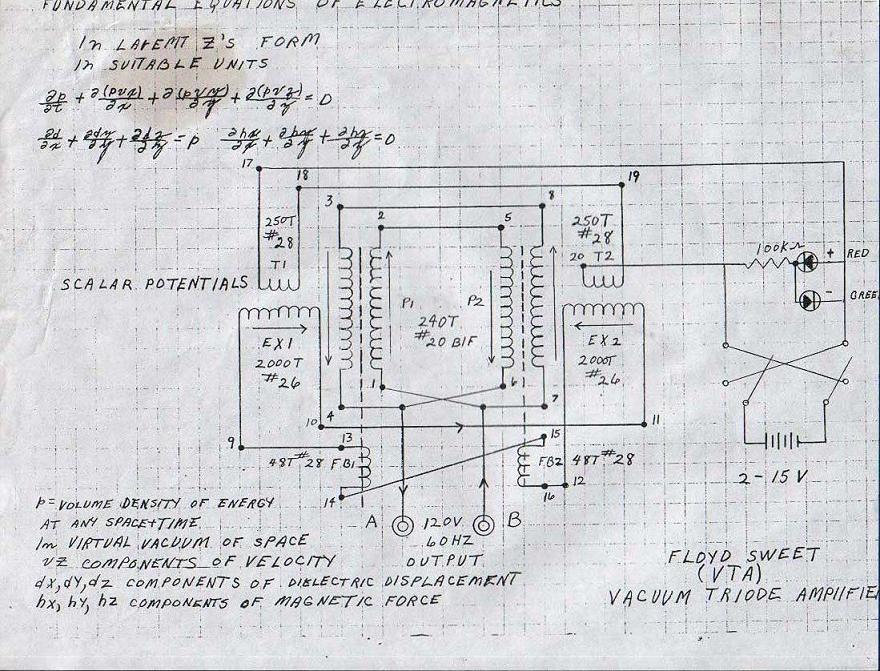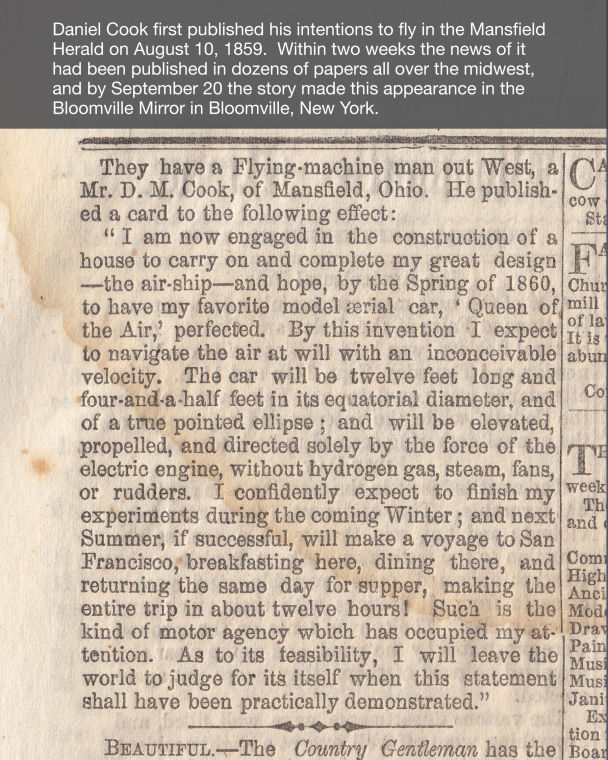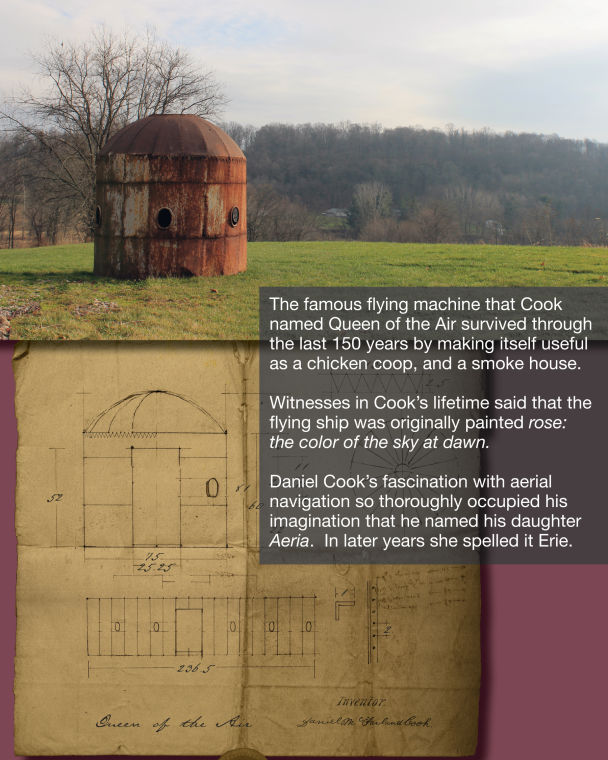Become a member of our Forum, and gain access to a lot more information!
Improvement In Induction-Coils, Electro-Magnetic Battery
None we know of
Be it known that I, Daniel McFarland Cook, of Mansfield, in the county of Richland and State of Ohio, have invented an Electro-Magnetic Battery, of which the following is a specification: My invention relates to the combination of two or more simple or compound helices and iron cores or magnets in such a manner as to produce a constant electric current without the aid of a galvanic battery.

The closest schematic I can find is actually Floyd Sweets:

Another Perpetual Motion Fiend
Mansfield, O., August 8. – For half a century D.M Cook has been a familiar figure in Richland County, and has been marked for his singular inventive genius. In 18?0 when a young man, he became impressed with the wonders of electrical science, and then became enamored of its study. He began to delve into the unknown of this hidden force, and for thirty-six years, in alternately brilliant and adverse circumstances, has trodden over this field till there is no nook or corner with which he is unacquainted.
He commenced his studies at a time when little was known of electricity, and by a pursuit of knowledge in that direction with unbounded zeal he has not only kept apace with the wizards of the day, but has so far gotten in advance of them that his assertions are almost accepted as altogether incredulous. But no matter whether his claims seem wonderful and almost beyond belief, they are worthy of credence, for he must be placed in the list of successful inventors. In 1852 he conceived and constructed a device that revolutionized the manufacture of sorghum syrup. The device was called an evaporator, and was used to make syrup from sorghum.
His principal was to run the juice across a heated surface in zigzag rows till the juice would run out as a pure syrup ready for the table, the water being evaporated in its passage, and the impurities being thrown to one side. On this he received letters patent in 1858, and in 1859 a company began the manufacture of the same. Thousands and thousands were disposed of, varying in price from $25 to $35, over $4,000,000 being realized, on which the inventor got a handsome royalty. Through this be derived quite a fortune, although a portion of it he spent in improving and introducing the device.
Even to this day a firm in Cincinnati is engaged in the manufacture of this same evaporator, from which the members of the firm made themselves rich. Cook, howver, several years ago lost his right to a royalty by some means or other, and has not been drawing anything from that source since. Save for this slight diversion, Mr. Cook has not experimentated in any field outside electricity since thirty-six years ago to any considerable extent, but in this direction can be said to have spent the greater part of his life.
For a while he sought to solve the quesiton of cheap power, light, etc. by producing the proper current by means of a battery. He invented a battery of peculiar value for telegraph purposes, which was in use for a long time at Crestline, on the Western Union, and until the discovery of the cheap gravity battery that is now in use. But Mr. Cook long ago concluded in his own mind that in dynamic electricity lay future success. Accordingly, he cast aside the battery as a secondary affair, and set about to experiment with dynamos of novel and pecular construction. For several years past he would occasionally meet me and speak of his discoveries in the electrical field, but would say that he had not yet secured the result he was after. He would tell me, "When I get my experiments completed I want to show you what will revolutionize the world.
I propose to make a perpetual electric generator or motor which will propel itself by its own current, the resistance of the generator proper being only about ten per cent. of the rotary power of the electric engine upon which tehichX the current of the generator acts." This assertion was sufficient to shock an ordinary person's nerves, but I accepted the statement with much allowance. However, I became interested and kept watching results.
Last November Mr. Cook came to me and said: "I have at last met with success. I have found the principle that I have been hunting for so long. I can now start a dynamo to going and it will never stop, except by the wearing away of its own parts. Not only will it run itself by its own current, but also produce power enough according the size of the engine, to run any machine in the world."
"Perpetual motion." I suggested. "More than that," he replied. "It is perpetual motion with only ten per cent. of the force used, leaving ninety per cent. for power to be utilized as is desired. Not only that, but more: one helix of my dynamo will produce light in proportion to its size, while the other is making the current that runs the engine. It will serve to heat your house, so that instead of having stoves and grates, little wires will run through your rooms, and on your parlor table will be a highly burnished apparatus containing wires, etc, which will keep the temperature of the house at whatever point you wish."
"What will be the cost to run it?" "Nothing. As I said, start it, and it will go. Heat, power and light produced by one machine, for absolutely nothing." I looked at him to see if he was there yet, and if so, whether he was mad, in earnest or joking. He laughed at my astonishment, and said: "I am now making a model, and when far enough along I will show it to you." The matter was not specially discussed after that although he would frequently bring up the question, until a day or two ago, and I had my serious doubts whether he would ever show the device to me. I thought of Keely and his motor, and felt that the results Mr. Cook professed himself able to obtain were such that he would keep secret his machine—if he had any—in order to mystify the public. My surprise may be imagined, therefore, when Mr. Cook came to me a few days ago and said: "I believe I will show you my electric engine and generator. I am far enough along now to show you how the results are accomplished."
A time was fixed, and at the appointed hour Mr. Cook called and took me to his farm, about three miles south of Mansfield. As an excuse for a heavy crop of weeds in a fine field, where hundreds of bushels of wheat should have been harvested, he explained: "I have been so busy with my researches that I have been unable to put out any crops. I could get nobody to attend to the farm, and therefore it is nothing but a barren waste. I succceeded in getting a few acres of oats planted, and that, with a small potato patch, will be all I will derive this year from this fine tract."
Here he lives, as he has lived for years, with a wife and fourteen-year old daughter and his wife's sister. The latter is his enthusiastic assistant, and has helped him in many long years of toil. Distant from the house stands an old shop, wherein is hidden the secrets of his life. No stranger ever enters here, for it is herein that are contained the results of thirty-six years of labor. This seclusive rule has been almost invariable, having been broken but half a dozen times in over a third of a century. Several electricians and two or three others of known integrity have been admitted but only after signing an iron-clad agreement not to reveal, patent, or cause to be patented, or improve without his consent, any of the parts shown to them.
The shop is dilapidated, as is the rest of the farm, so much is his mind taken up in the pursuit of his studies. The rear is used as a shelter for his trusty old horse, who has done near thirty years of royal service, while the front part is devoted altogether to his laboratory.
The agreement signed, Mr. Cook led the way to the door, but before unlocking it grasped me by the hand and bade me renew the promise made in the written agreement. This done, I was ushered into the mysterious room. I was bewildered bty the apparance of the place. The room was large, and everywhere hung bundles of wire. Magnets of all shapes and sizes hung about the walls, and were scattered on the floor in conufused heaps. In one corner was a huge machine, with large coils and magnets, which Mr. Cook toild me was the first machine he attempted to make. But in the center of the room sat the pride of his life. I saw at a glance that this mysterious man had not wasted his time and fortune. He had branched out from the beaten track, and had produced a machine that differed in all respects from dynamos of present construction, except that he also used wire and iron.
"This," said he, "is my perpetual electric generator and engine. I will call my assistant and show you how it works."
The machine was rudely constructed, for Mr. Cook made it all himself with a few old tools that had done too much service already. Parts of it were made of wood, and the whole was not put together in a very artistic manner, but it demonstrated his discoveries, and that was his only purpose in its construction. This model weighs three hundred pounds, and Mr. Cook said by the hand power of one man could be generated current sufficient to light up from thirty to fifty sixteen candle-power incandescent lamps.
His assistant having arrived, who by the way is a young lady of handsome appearance, the work of demonstration began. I tested the current in several ways and found it very powerful. Having made electricity somewhat of a study I was surprised at the simplicity of many of the principles. The manner in which he expected to get the results heretofore mentioned, is theoretically correct, and there is no mechanical difficulty which he has not already overcome.
After examing the machine carefuly in all its parts, I was conducted to an adjoining room, where, on a table, sat a smaller model of more accurate make. It contained a much better arrangement of the parts, and from what he told me I am compelled to believe all that Mr. Cook had told me. I asked him why he had not sought capital to develop his theories more rapidly, when he replied that he had not heretofore been ready. He said:
"I wanted to complete my labors so that I could say my work is done. I desired to give to the world a machine perfect in every particular, that would settle forevermore the question of cheap power, light and heat. Up to now my work was not finished. I am now almost done. Within a very short time I shall be able to show to all mankind that I have a machine that will revolutionize the world. When I can exhibit a running model, which I can in a few days, then I will be ready to consider the many propositions that I have already received."
Mr. Cook is about sixty-six years of age, and a more polished gentleman is hard to find. He is a fluent speaker, and Xsentences are always grammatically correct. He has a wonderful flow of language, and his perfect knowledge of electricity becomes known in five minutes conversation on the subject. He is familiar with all the electrical contrivances of the day, and it is a well-known fact that many years ago he lighted his own house by electricity, and long before electric light was known to the general public.
He has made over one million experiments in his lifetime, and constructed over two hundred thousand models. He has thoroughly explored the electric field, and his inventions embody all that is valuable in electric light, electro-motors and electric generators beyond what is now before the public. Mr. Cook is a scientist in the broadest acceptance of the term, and is certainly one of the most thorough and faithful students of the electrical forces of this day, having spent over $50,000 in order to to gain a full knowledge of this occult fluid. –W.F.H in Cincinnati Commercial Gazette.
Found and Transcribed by Fred Epps, 19 Feb 2015
below, on page 174 5 and 6 you will find Coils that approximate the Coils of Daniel McFarland Cook, also references to the "Galvanic Battery"
Davis's manual of magnetism. Including also electro-magnetism, magneto-electricity, and thermo-electricity. With a description of the electrotype process. For the use of students and literary institutions. With 100 original illustrations



This content is based on the excellent work from: Mansfield's D.M. Cook and his enduring energy - Timothy Brian McKee, Columnist Jan 11, 2014